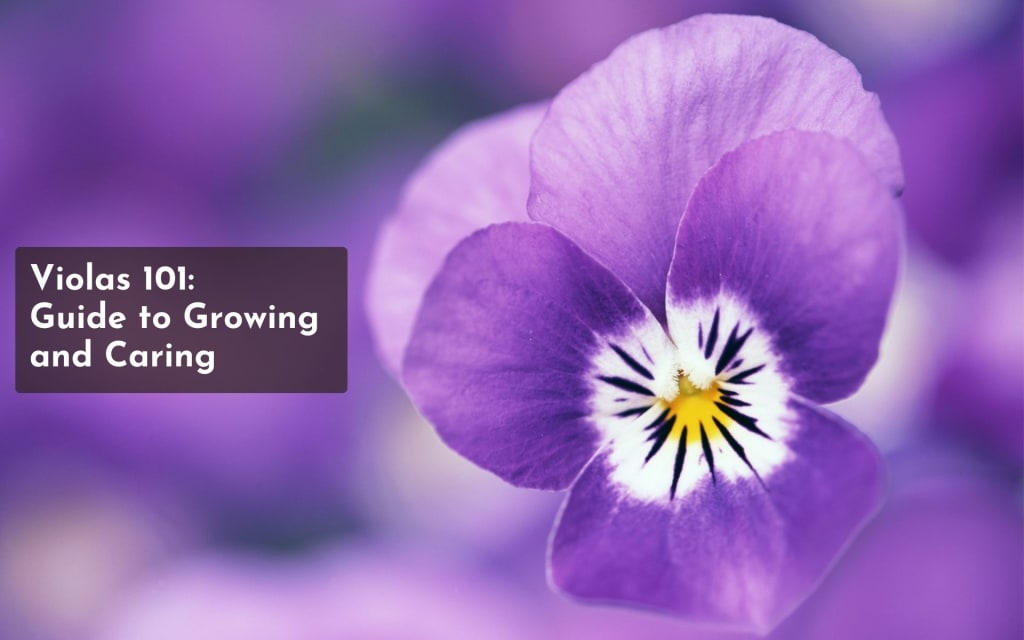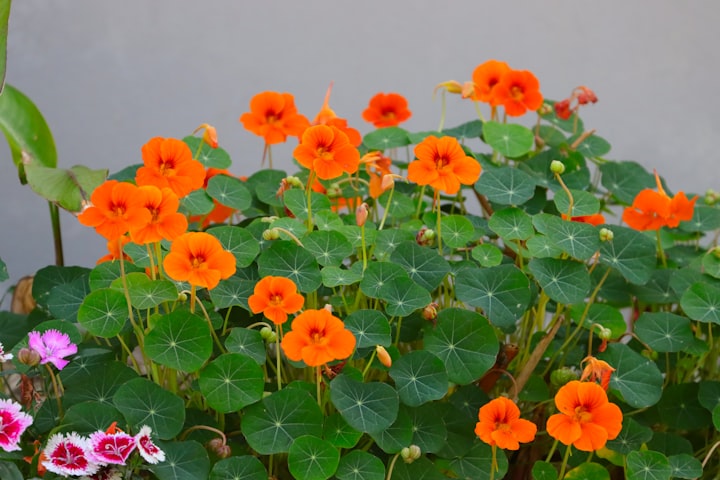Violas 101: Guide to Growing and Caring for Viola Flowers
Violaceae

Violas are a genus of flowering plants in the family Violaceae. They are herbaceous plants that are typically low-growing and produce colorful flowers. Viola flowers come in various colors, including purple, yellow, white, blue, and bi-color variations.
Violas are known for their delicate and charming appearance. The flowers have five petals, with the lower petal often having distinct markings or a contrasting color pattern. They are popular garden plants often used in containers, borders, and flower beds. They are also frequently seen in spring and fall gardens, as they can tolerate cooler temperatures.
Types of Violas
Violas encompass various cultivars, each with unique characteristics, colors, and growth habits. Familiarize yourself with some popular types of Violas to choose the ones that best suit your gardening preferences:
- Pansies (Viola × wittrockiana): Pansies are known for their large, vibrant flowers with "faces" or blotch markings in contrasting colors. They come in a wide range of hues, including shades of purple, yellow, white, blue, and orange. Pansies are often prized for their cold hardiness and ability to bloom during cooler seasons.
- Viola cornuta: Also known as horned violets, Viola cornuta features dainty flowers with slender spurs at the base. They typically bloom in spring and have a more delicate appearance than pansies. The flowers come in various colors: purple, lavender, yellow, and white.
- Viola tricolor: Commonly called Johnny Jump-ups or wild pansies, Viola tricolor features smaller flowers with distinctive markings. The blooms have a combination of purple, yellow, and white petals, often with intricate patterns. They are known for their charming and whimsical appearance.
- Viola odorata: Also known as sweet violets, Viola odorata produces highly fragrant flowers. They have a more subtle color palette, with purple, blue, and white shades. The fragrance of these violets adds an enchanting element to the garden.
- Viola hederacea: Also called Australian violets or trailing violets, Viola hederacea is a low-growing variety with small flowers and trailing stems. They are often used as ground covers or in hanging baskets, providing a cascade of delicate blooms. Colors range from purple and white to pink and blue.
- Viola sororia: Known as the common blue violet or meadow violet, Viola sororia is a native North American species. It features heart-shaped leaves and produces small, deep purple or blue-violet flowers. These violets are valued for their ability to naturalize in woodland gardens.
These are just a few examples of the many types of Violas available. Each variety brings its unique charm and characteristics to the garden, allowing you to create captivating displays of color and texture.
Join today to share and publish your content on Vocal Media and earn money.
Ideal Growing Conditions for Violas
Violas thrive in specific growing conditions, and providing them with the optimal environment will ensure their health and vitality. Consider the following factors when creating an ideal setting for your Viola garden:
Sunlight: Violas prefer partial shade to full sun, depending on your climate. Providing them with some afternoon shade in warmer regions can help prevent heat stress and prolong blooming. However, they can tolerate more sun in cooler climates. Aim for at least 4-6 hours of direct sunlight per day.
Soil: Violas prefer well-draining soil with a slightly acidic to neutral pH range of 6.0 to 7.0. Rich and fertile soil with organic matter will promote healthy growth. If your soil is heavy or clay-like, consider amending it with compost or well-rotted organic matter to improve drainage.
Also Read: Growing and Maintaining Hydrangea Plants
Moisture: Violas prefer evenly moist soil but are susceptible to root rot if the soil becomes waterlogged. Regularly watering ensures the soil doesn't dry out completely between waterings. Mulching around the plants can help retain moisture and regulate soil temperature.
Temperature: Violas are cool-season flowers that thrive in mild to cool temperatures. They perform best in spring and fall when temperatures range between 50°F and 70°F (10°C to 21°C). In hotter regions, choose heat-tolerant varieties and provide them with shade during the hottest parts of the day.
Air Circulation: Good air circulation is essential to prevent fungal diseases and promote plant health. Avoid overcrowding Viola plants and provide enough spacing between them to allow air to circulate freely.
Planting Violas
Violas can be grown from seeds or transplants; proper planting techniques are crucial for their successful establishment. Follow these steps to ensure a healthy start for your plants:
Seed Planting
- Timing: Start Viola seeds indoors 8-10 weeks before your area's last expected frost date. This will give the seedlings ample time to develop before transplanting them outdoors.
- Soil Preparation: Use a seed-starting mix or a well-draining soilless medium to sow the Viola seeds. Fill seed trays or small pots with the mix and lightly tamp it down to provide a firm planting surface.
- Sowing the Seeds: Sprinkle the Viola seeds evenly over the soil surface, ensuring they are not buried too deeply. Lightly press them into the soil or cover them with a thin layer of vermiculite or fine soil.
- Watering: Gently water the seeds from below by placing the seed tray in a shallow water container. This prevents the seeds from being displaced. Once the soil surface is evenly moist, remove the tray from the water and allow any excess to drain.
- Germination: Place the seed trays in a warm and bright location, ideally between 60°F and 70°F (15°C to 21°C). Viola seeds typically germinate within 10-21 days. Keep the soil consistently moist during this period.
- Transplanting: When the Viola seedlings have developed their second set of true leaves, they are ready for transplanting. Harden off the seedlings by gradually exposing them to outdoor conditions for 7-10 days. Then, transplant them into well-prepared garden beds or containers, spacing them according to the specific variety's recommendations.
Transplanting
- Timing: Transplant Viola seedlings outdoors when the danger of frost has passed, and the soil has warmed up. This is typically in early spring or fall, depending on your climate.
- Soil Preparation: Prepare the planting area by removing weeds, loosening the soil, and incorporating organic matter to improve fertility and drainage.
- Digging Holes: Dig holes in the prepared soil that are slightly larger than the root ball of the Viola seedlings. Space the holes according to the recommended spacing for the specific variety.
- Transplanting: Carefully remove the seedlings from their containers, not disturbing the roots excessively. Place each seedling in a hole, ensuring that the top of the root ball is level with the soil surface. Backfill the hole with soil, gently firming it around the roots.
- Watering: After transplanting, water the seedlings thoroughly to settle the soil and eliminate any air pockets around the roots.
Viola Care
Violas are relatively low-maintenance flowers, but proper care ensures their health, vigor, and continuous blooming. Follow these guidelines to provide optimal care for your Viola plants:
Watering
- Moisture Levels: Violas prefer evenly moist soil, so it's important to maintain consistent moisture without waterlogging the plants. Monitor the soil moisture regularly and adjust the watering accordingly.
- Watering Techniques: Water the soil around the base of the plants, aiming to keep the foliage dry to minimize the risk of fungal diseases. Avoid overhead watering, which can lead to leaf spots or mildew.
- Mulching: Apply a layer of organic mulch, such as shredded bark or compost, around the Viola plants. Mulching helps conserve soil moisture, regulate temperature, and suppress weed growth.
Read Also: Guide to Growing Hellebore Flowers
Fertilization
- Nutrient Requirements: Violas benefit from regular feeding to promote healthy growth and abundant blooms. Apply a balanced, slow-release, or liquid fertilizer diluted according to the package instructions. Start fertilizing when the plants have established themselves and continue regularly throughout the growing season.
- Feeding Frequency: Generally, fertilize Violas every 4-6 weeks. However, always refer to the specific fertilizer's instructions for the recommended feeding schedule and application rates.
Pruning and Deadheading
- Deadheading: To encourage continuous blooming, remove spent flowers by pinching or snipping them off at the base of the stem. Deadheading redirects energy into new flower production rather than seed formation.
- Pruning: If Violas become leggy or develop straggly growth, prune them back by trimming the stems to just above a set of healthy leaves. This promotes bushier growth and maintains a neater appearance.
Managing Pests and Diseases
- Pest Control: Watch for common pests that may affect Violas, such as aphids, slugs, and snails. Use organic pest control methods like handpicking, spraying with insecticidal soap, or introducing beneficial insects to keep pest populations in check.
- Disease Prevention: Violas can be susceptible to fungal diseases like powdery mildew or gray mold. To prevent these diseases, provide good air circulation by spacing plants adequately and avoiding overhead watering. If necessary, apply fungicides following the manufacturer's instructions.
Winter Care
- Hardy Varieties: Some Viola varieties are more cold-tolerant than others. If you live in a region with mild winters, these hardy varieties may survive outdoors during the winter with minimal protection.
- Mulching and Covering: For colder climates, protect Violas during winter by applying a layer of mulch around the plants. Additionally, cover them with frost blankets or cloths during periods of extreme cold to shield them from freezing temperatures.
Creative Uses for Violas
Violas are beautiful in the garden and lend themselves to various creative applications. Explore these imaginative uses for Violas to enhance the visual appeal of your outdoor space:
Container Gardening
Pots and Planters: Plant Violas in containers of different sizes, shapes, and colors to create stunning focal points on patios, balconies, or entryways. Mix and match Viola varieties with complementary flowers or foliage plants to achieve captivating arrangements.
Hanging Baskets: Hang baskets filled with trailing Violas from hooks or brackets, adding a cascade of color to walls, fences, or pergolas. Combine them with other trailing plants like ivy or trailing lobelia for an enchanting display.
Edging and Borders
Pathway Accents: Line garden pathways with Violas to create a charming and colorful border. Use a mix of colors, or choose a single hue for a cohesive look.
Floral Borders: Plant Violas along the edges of flower beds to provide a vibrant and eye-catching frame for your garden. Experiment with color combinations to complement the surrounding plants.
Living Mosaics
Floral Mosaic Designs: Arrange Violas in patterns or designs to create living mosaics. Use different colors to form intricate shapes or create a mosaic effect within designated garden areas.
Geometric Patterns: Plant Violas in geometric shapes like circles, squares, or triangles to create visually striking designs. This unique use of Violas adds a touch of artistry to your garden.
Companion Planting
Flower Combinations: Pair Violas with other flowering plants with complementary colors, heights, and bloom times. For example, combine them with daffodils or tulips in spring for a delightful early-season display.
Foliage Contrast: Use Violas as a backdrop for plants with contrasting foliage colors or textures. The Viola's compact form and vibrant flowers can provide a stunning backdrop for taller plants or ornamental grasses.
Floral Crafts
Cut Flower Arrangements: Harvest Viola blooms for use in fresh-cut flower arrangements. Their dainty flowers and long vase life make them perfect for adding a touch of charm to bouquets and floral centerpieces.
Pressed Flower Crafts: Press Viola flowers to preserve their beauty and use them in crafts such as card-making, scrapbooking, or creating botanical art pieces. The vibrant colors of pressed Viola blooms add a whimsical touch to these creative projects.
Wrapping Up
As we conclude this guide on Violas, it's clear that these charming flowers offer endless possibilities for creative expression in your garden. Whether you're a passionate gardener, a budding artist, or simply someone who appreciates the beauty of nature, Viola flowers provide an enchanting canvas to explore your creativity.
Violas bring color, texture, and whimsy to any outdoor space, from container gardens and hanging baskets to pathway borders and living mosaics. Their versatility allows you to experiment with various combinations, patterns, and designs, turning your garden into a captivating work of art.
So, let your imagination soar and unleash your creativity. Transform your outdoor space into a haven of color, inspiration, and artistic expression. Whether creating intricate designs or simply enjoying the joyous sight of Violas in bloom, these flowers will bring a touch of enchantment to your garden and fill your heart with joy.
Now, go forth and embrace the creative possibilities that Violas offer, and let the beauty of these delightful flowers inspire you to create a garden that reflects your unique artistic vision.
👉 Do you have any additional insights or questions? We highly value your feedback. Please share your thoughts by leaving a comment below.
About the Creator
Amir Hossain
I blog on everything and anything— hoping my blogs will make your days a bit happier!






Comments
There are no comments for this story
Be the first to respond and start the conversation.